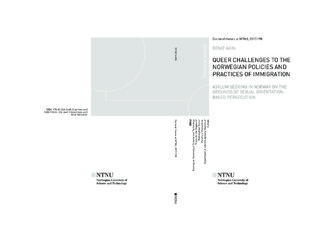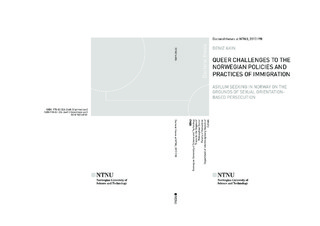| dc.contributor.advisor | Ringrose, Priscilla Marie | |
| dc.contributor.advisor | Bolsø, Agnes | |
| dc.contributor.author | Akin, Deniz | |
| dc.date.accessioned | 2017-07-13T08:51:32Z | |
| dc.date.available | 2017-07-13T08:51:32Z | |
| dc.date.issued | 2017 | |
| dc.identifier.isbn | 978-82-326-2469-0 | |
| dc.identifier.issn | 1503-8181 | |
| dc.identifier.uri | http://hdl.handle.net/11250/2448634 | |
| dc.description.abstract | Summary of the thesis
Ensuring legal protection based on sexual orientation under refugee law has been an ongoing struggle for both legal advocates and non-governmental organizations working in the field. Despite the fact that sexual orientation is now widely accepted as a ground for asylum in many asylum receiving countries (Berg and Millbank 2009, Spijkerboer and Jansen 2011), the inclusion of sexual minorities under the Refugee Convention poses particular challenges centralized around the interpretation and application of asylum law to sexual orientation-based applications. It also prompts the question of how sexual identities and meanings are constructed in the nexus of global sexual politics and discourse around refugees.
This dissertation is about queer asylum-seekers in Norway, that is, people who seek protection on the grounds of their non-conforming sexual orientation, and the queer challenges they bring to the Norwegian policies and practices of immigration. The reason I refer to various political and practical issues raised by queer asylum seekers’ protection claim as ‘queer challenges’ is not only because that the claimants are allegedly queer. It is also an attempt of underlying the difficulty, if not impossibility, of rendering queer asylum seekers’ sexual orientation, upon which they seek protection, genuine.
Three articles in this dissertation explore how Norwegian immigration authorities understand a genuine sexual orientation and a credible risk of persecution that determines queer claimants’ entitlement to asylum in Norway. In doing so the articles discuss the bureaucratic and practical dimensions of queer asylum seekers’ applications in Norway, and they flesh out the significance of these cases for a theoretical discussion of cultural and sexual politics in Norway.
The first article investigates how Norwegian adjudicators run the credibility assessment for queer asylum seekers. The empirical material for this article is based on six semi-structured interviews conducted with asylum caseworkers of the Norwegian Directorate of Immigration. The second article analyzes the case of an Iranian asylum seeker by concentrating on the aesthetic and cultural adjustments that the applicant made to his life which seem to increase his chances of winning asylum. The third article investigates how queer asylum seekers translate their sexuality to be readable within the Norwegian asylum context. For this study, the empirical material for analysis draws upon 10 semi-structured interviews conducted in Trondheim and Oslo.
In reading the three articles together, it is possible to see how Norwegian laws and regulations of asylum are informed by both national and global cultural politics of immigration and sexuality. Therefore, seeking solutions to the queer challenges by merely focusing on the practice of adjudicators would probably be constraining. Rather, attentiveness to how the discourses on issues such as, deserving immigrants, worthy asylum seekers, healthy sexualities, good citizens are reproduced and circulated, would provide us with a more useful and comprehensive lens to understand the aspects of power imbalance impacting the outcome of asylum evaluations. | nb_NO |
| dc.description.abstract | Sammendrag av avhandlingen
Det har vært en langvarig og kontinuerlig kamp for advokater og frivillige organisasjoner som jobber med norsk innvandringspolitikk å kunne gi asylsøkere som forfølges på grunn av sin seksuelle orientering sikker og god juridisk beskyttelse i henhold til flyktningloven. Til tross for at det er et allment akseptert grunnlag å gi asyl til personer som forfølges på grunn av sin seksuelle orientering i flere land, (Berg and Millbank 2009, Spijkerboer and Jansen 2011), skaper denne inkluderingen av seksuelle minoriteter under Flyktningkonvensjonen spesielle utfordringer rundt tolkningen og anvendelsen av asylloven når det kommer til seksuelt orienteringsbaserte søknader om asyl. Problemstillingen danner også spørsmål om hvordan seksuelle identiteter og betydninger er konstruert i sammenheng med global seksuell politikk og diskursen om flyktninger.
Denne avhandlingen handler om skeive asylsøkere i Norge, nærere definert som personer som søker beskyttelse på grunn av sin seksuelle orientering, og utfordringene dette gir i norsk politikk og praksis for innvandring. Årsaken til at jeg refererer til ulike politiske og praktiske spørsmål som oppstår når skeive personer søker asyl som «skeive utfordringer», skyldes ikke bare at søkeren er skeiv. Det er også et forsøk på å understreke vanskeligheten, om ikke umuligheten, med å gjengi grunnlaget skeive asylsøkere søker beskyttelse for, som ekte.
De tre artikler i denne avhandlingen undersøker hvordan norske innvandringsmyndigheter forstår hva seksuell orientering blant asylsøkere går ut på, og hvordan de vurderer risikoen for forfølgelse, som jo avgjør om søkeren har rett til asyl. I den sammenhengen drøfter artiklene de ulike byråkratiske og praktiske aspektene ved søknader om asyl fra skeive søkere i Norge. De gjør også rede for betydningen disse sakene har for teoretiske diskusjoner om kultur- og seksualitetspolitikk i Norge.
Den første artikkelen undersøker hvordan norske myndigheter vurderer troverdigheten til skeive asylsøkere. Det empiriske materialet til denne artikkelen er basert på seks semi-strukturerte intervju med saksbehandlere som jobber med asylsøknader i Utlendingsdirektoratet. Den andre artikkelen analyserer saken som handler om en iransk asylsøker som gjorde bestemte estetiske og kulturelle tilpasninger i sitt hverdagsliv for å øke sjansen for å få asyl. Den tredje artikkelen undersøker hvordan skeive asylsøkere ’oversetter’ sin seksualitet til å bli forståelig i en norsk asylpolitisk kontekst. Her bygger det empiriske analysematerialet på 10 semi-strukturerte intervju utført i Trondheim og Oslo.
Om man leser disse tre artiklene samlet er det mulig å se hvordan lover og forskrifter innen norsk asylpolitikk påvirkes av både en nasjonal og global kulturpolitikk om innvandring og seksualitet. Å søke løsninger på skeive utfordringer ved utelukkende å fokusere på norske myndigheters asylpraksis, vil gi begrenset innsikt. Det vil i stedet være fruktbart å rette oppmerksomheten mot hvordan diskurser om det å være en fortjenende og verdig asylsøker, om sunn seksualitet og om gode borgere reproduseres og sirkuleres. Det vil gi oss mer nyttig og omfattende kunnskap om aspektene av maktubalanse som påvirker utfallet av asylevalueringer. | nb_NO |
| dc.language.iso | eng | nb_NO |
| dc.publisher | NTNU | nb_NO |
| dc.relation.ispartofseries | Doctoral theses at NTNU;2017:198 | |
| dc.relation.haspart | Paper 1:
Akin, Deniz.
Assessing sexual orientation-based persecution : a closer look at the Norwegian practices of asylum evaluation of gay and lesbian claimants. Lambda Nordica: Tidskrift om homosexualitet 2015 ;Volum 20.(1) s. 21-42 | |
| dc.relation.haspart | Paper 2:
Becoming Family: Orientalism, Homonormativity, and Queer Asylum in Norway | |
| dc.relation.haspart | Paper 3:
Akin, Deniz.
"Queer asylum seekers: translating sexuality in Norway." Journal of ethnic and migration studies 2016 ;Volum 43.(3) s. 458-474,
available online:
http://dx.doi.org/10.1080/1369183X.2016.1243050 | |
| dc.title | QUEER CHALLENGES TO THE NORWEGIAN POLICIES AND PRACTICES OF IMMIGRATION: ASYLUM SEEKING IN NORWAY ON THE GROUNDS OF SEXUAL ORIENTATION-BASED PERSECUTION | nb_NO |
| dc.type | Doctoral thesis | nb_NO |
| dc.subject.nsi | VDP::Humanities: 000::Cultural science: 060 | nb_NO |

